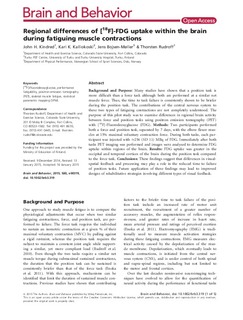| dc.contributor.author | Kindred, John H. | |
| dc.contributor.author | Kalliokoski, Kari K. | |
| dc.contributor.author | Bojsen-Møller, Jens | |
| dc.contributor.author | Rudroff, Thorsten | |
| dc.date.accessioned | 2016-04-06T08:10:10Z | |
| dc.date.available | 2016-04-06T08:10:10Z | |
| dc.date.issued | 2015-02-17 | |
| dc.identifier.citation | Brain and Behavior. 2015, 5, 4. | nb_NO |
| dc.identifier.uri | http://hdl.handle.net/11250/2384151 | |
| dc.description | © 2015 The Authors. Brain and Behavior published by Wiley Periodicals, Inc.
This is an open access article under the terms of the Creative Commons Attribution License, which permits use, distribution and reproduction in any medium, provided the original work is properly cited. | nb_NO |
| dc.description.abstract | Background and Purpose: Many studies have shown that a position task is more difficult than a force task although both are performed at a similar net muscle force. Thus, the time to task failure is consistently shown to be briefer during the position task. The contributions of the central nervous system to these two types of fatiguing contractions are not completely understood. The purpose of this pilot study was to examine differences in regional brain activity between force and position tasks using positron emission tomography (PET) with [18F]-Fluorodeoxyglucose (FDG). Methods: Two participants performed both a force and position task, separated by 7 days, with the elbow flexor muscles at 15% maximal voluntary contraction force. During both tasks, each participant was injected with ≈256 (SD 11) MBq of FDG. Immediately after both tasks PET imaging was performed and images were analyzed to determine FDG uptake within regions of the brain. Results: FDG uptake was greater in the occipital and temporal cortices of the brain during the position task compared to the force task. Conclusions: These findings suggest that differences in visual-spatial feedback and processing may play a role in the reduced time to failure of position tasks. Future application of these findings may lead to improved designs of rehabilitative strategies involving different types of visual feedback. | nb_NO |
| dc.language.iso | eng | nb_NO |
| dc.publisher | John Wiley & Sons | nb_NO |
| dc.subject | performance fatigability | nb_NO |
| dc.subject | [18F]-fluorodeoxyglucose | nb_NO |
| dc.subject | positron emission tomography (PET) | nb_NO |
| dc.subject | skeletal muscle fatigue | nb_NO |
| dc.subject | statistical parametric mapping (SPM) | nb_NO |
| dc.title | Regional differences of [18F]-FDG uptake within the brain during fatiguing muscle contractions. | nb_NO |
| dc.type | Journal article | nb_NO |
| dc.type | Peer reviewed | nb_NO |
| dc.subject.nsi | VDP::Social science: 200 | nb_NO |
| dc.subject.nsi | VDP::Social science: 200::Psychology: 260 | nb_NO |
| dc.subject.nsi | VDP::Social science: 200::Psychology: 260::Biological psychology: 261 | nb_NO |
| dc.subject.nsi | VDP::Medical disciplines: 700 | nb_NO |
| dc.subject.nsi | VDP::Medical disciplines: 700::Clinical medical disciplines: 750 | nb_NO |
| dc.subject.nsi | VDP::Medical disciplines: 700::Clinical medical disciplines: 750::Neurology: 752 | nb_NO |
| dc.subject.nsi | VDP::Medical disciplines: 700::Clinical medical disciplines: 750::Psychiatry, child psychiatry: 757 | nb_NO |
| dc.source.journal | Brain and Behavior | nb_NO |
| dc.identifier.doi | 10.1002/brb3.319 | |
| dc.description.localcode | Seksjon for fysisk prestasjonsevne / Department of Physical Performance | nb_NO |
